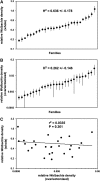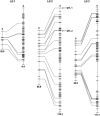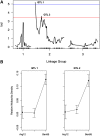Cytonuclear Epistasis Controls the Density of Symbiont Wolbachia pipientis in Nongonadal Tissues of Mosquito Culex quinquefasciatus
- PMID: 28606944
- PMCID: PMC5555468
- DOI: 10.1534/g3.117.043422
Cytonuclear Epistasis Controls the Density of Symbiont Wolbachia pipientis in Nongonadal Tissues of Mosquito Culex quinquefasciatus
Abstract
Wolbachia pipientis, a bacterial symbiont infecting arthropods and nematodes, is vertically transmitted through the female germline and manipulates its host's reproduction to favor infected females. Wolbachia also infects somatic tissues where it can cause nonreproductive phenotypes in its host, including resistance to viral pathogens. Wolbachia-mediated phenotypes are strongly associated with the density of Wolbachia in host tissues. Little is known, however, about how Wolbachia density is regulated in native or heterologous hosts. Here, we measure the broad-sense heritability of Wolbachia density among families in field populations of the mosquito Culex pipiens, and show that densities in ovary and nongonadal tissues of females in the same family are not correlated, suggesting that Wolbachia density is determined by distinct mechanisms in the two tissues. Using introgression analysis between two different strains of the closely related species C. quinquefasciatus, we show that Wolbachia densities in ovary tissues are determined primarily by cytoplasmic genotype, while densities in nongonadal tissues are determined by both cytoplasmic and nuclear genotypes and their epistatic interactions. Quantitative-trait-locus mapping identified two major-effect quantitative-trait loci in the C. quinquefasciatus genome explaining a combined 23% of variance in Wolbachia density, specifically in nongonadal tissues. A better understanding of how Wolbachia density is regulated will provide insights into how Wolbachia density can vary spatiotemporally in insect populations, leading to changes in Wolbachia-mediated phenotypes such as viral pathogen resistance.
Keywords: Culex quinquefasciatus; QTL mapping; Wolbachia density; Wolbachia pipientis; cytonuclear epistasis.
Copyright © 2017 Emerson, Glaser.
Figures




Similar articles
-
Somatic Wolbachia (Rickettsiales: Rickettsiaceae) levels in Culex quinquefasciatus and Culex pipiens (Diptera: Culicidae) and resistance to West Nile virus infection.J Med Entomol. 2014 Jan;51(1):189-99. doi: 10.1603/me13152. J Med Entomol. 2014. PMID: 24605469
-
Disruption of the Wolbachia surface protein gene wspB by a transposable element in mosquitoes of the Culex pipiens complex (Diptera, Culicidae).Insect Mol Biol. 2007 Apr;16(2):143-54. doi: 10.1111/j.1365-2583.2006.00707.x. Epub 2007 Feb 6. Insect Mol Biol. 2007. PMID: 17298560
-
What can symbiont titres tell us about co-evolution of Wolbachia and their host?J Invertebr Pathol. 2014 May;118:20-7. doi: 10.1016/j.jip.2014.02.009. Epub 2014 Mar 1. J Invertebr Pathol. 2014. PMID: 24594301
-
Wolbachia pipientis: intracellular infection and pathogenesis in Drosophila.Curr Opin Microbiol. 2004 Feb;7(1):67-70. doi: 10.1016/j.mib.2003.12.003. Curr Opin Microbiol. 2004. PMID: 15036143 Review.
-
A host as an ecosystem: Wolbachia coping with environmental constraints.Environ Microbiol. 2014 Dec;16(12):3583-607. doi: 10.1111/1462-2920.12573. Epub 2014 Aug 18. Environ Microbiol. 2014. PMID: 25052143 Review.
Cited by
-
Changes in the frequency of facultative endosymbionts in insect populations: overview and applications.Entomol Gen. 2025 May 22;45(2):351-368. doi: 10.1127/entomologia/2025/3052. Epub 2025 May 7. Entomol Gen. 2025. PMID: 40534619 Free PMC article.
-
Cross-tissue and generation predictability of relative Wolbachia densities in the mosquito Aedes aegypti.Parasit Vectors. 2022 Apr 12;15(1):128. doi: 10.1186/s13071-022-05231-9. Parasit Vectors. 2022. PMID: 35413938 Free PMC article.
-
Molecular identification of Wolbachia and Sodalis glossinidius in the midgut of Glossina fuscipes quanzensis from the Democratic Republic of Congo.Parasite. 2019;26:5. doi: 10.1051/parasite/2019005. Epub 2019 Feb 7. Parasite. 2019. PMID: 30729921 Free PMC article.
References
-
- Bourtzis K., Dobson S. L., Xi Z., Rasgon J. L., Calvitti M., et al. , 2014. Harnessing mosquito-Wolbachia symbiosis for vector and disease control. Acta Trop. 132: S150–S163. - PubMed
Publication types
MeSH terms
LinkOut - more resources
Full Text Sources
Other Literature Sources
